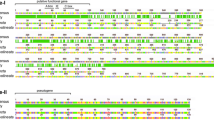Abstract
In Drosophila, heat shock protein 27 (Hsp27) is a critical single-copy intron-free nuclear gene involved in the defense response against fungi and bacteria, and is a regulator of adult lifespan. In the present study, 33 homologous Hsp27 nucleotide sequences from different Drosophila species were amplified by PCR and reverse transcription PCR, and the phylogenetic relationships were analysed using neighbour-joining, maximum-likelihood and Bayesian methods. The phylogenetic topologies from analysis with different algorithms were similar, suggesting that the Hsp27 gene was split by a recently acquired intron during the evolution of the Drosophila ananassae subgroup.




Similar content being viewed by others
References
Clark A. R., Naylor C. E., Bagneris C., Keep N. H. and Slingsby C. 2011 Crystal structure of R120G disease mutant of human α, β-crystallin domain dimer shows closure of a groove. J. Mol. Biol. 408, 118–134.
Coghlan A. and Wolfe K. H. 2004 Origins of recently gained introns in Caenorhabditis. Proc. Natl. Acad. Sci. USA 101, 11362–11367.
Corces V., Holmgren R., Freund R., Morimoto R. and Meselson M. 1980 Four heat shock proteins of Drosophila melanogaster coded within a 12-kilobase region in chromosome subdivision 67B. Proc. Natl. Acad. Sci. USA 77, 5390–5393.
Da Lage J. L., Kergoat G. J., Maczkowiak F., Silvain J. F., Cariou M. L. and Lachaise D. 2007 A phylogeny of Drosophilidae using the Amyrel gene: questioning the Drosophila melanogaster species group boundaries. J. Zoo. Syst. Evol. Res. 45, 47–63.
Edgar R. C. 2004 MUSCLE: multiple sequence alignment with high accuracy and high throughput. Nucleic Acids Res. 32, 1792–1797.
Hartung F., Blattner F. R. and Puchta H. 2002 Intron gain and loss in the evolution of the conserved eukaryotic recombination machinery. Nucleic Acids Res. 30, 5175–5181.
Hartl F. and Hayer-Hartl M. 2002 Molecular chaperones in the cytosol: from nascent chain to folded protein. Science 295, 1852–1858.
He Z., Eichel K. and Ruvinsky I. 2011 Functional conservation of cis-regulatory elements of heat-shock genes over long evolutionary distances. PLoS One 6, e22677.
Huelsenbeck J. P. and Ronquist F. 2001 MRBAYES: Bayesian inference of phylogenetic trees. Bioinformatics 17, 754–755.
Lockhart P., Novis P., Milligan B. G., Riden J., Rambaut A. and Larkum T. 2006 Heterotachy and tree building: a case study with plastids and eubacteria. Mol. Biol. Evol. 23, 40–45.
Maria R., Valet J. P. and Tanguay R. M. 1993 Hsp23 and Hsp26 exhibit distinct spatial and temporal patterns of constitutive expression in Drosophila adults. Dev. Gen. 14, 69–77.
Nylander J. A. A. 2004 MrModeltest v2. A program distributed by the author. Evolutionary Biology Centre, Uppsala University, Sweden.
Qiu W. G., Schisler N. and Stoltzfus A. 2004 The evolutionary gain of spliceosomal introns: sequence and phase preferences. Mol. Biol. Evol. 21, 1252–1263.
Ragg H. 2011 Intron creation and DNA repair. Cell Mol. Life Sci. 68, 235–254.
Rodrıguez-Trelles F., Tarrıo R. and Ayala F. J. 2006 Origins and evolution of spliceosomal introns. Annu. Rev. Genet. 40, 47–76.
Roy S. W. and Irimia M. 2009 Mystery of intron gain: new data and new models. Trends Genet. 25, 67–73.
Roy S. W. and Gilbert W. 2006 The evolution of spliceosomal introns: patterns, puzzles and progress. Nat. Rev. Genet. 7, 211–221.
Ruano-Rubio V. and Fares M. A. 2007 Artifactual phylogenies caused by correlated distribution of substitution rates among sites and lineages: the good, the bad, and the ugly. Syst. Biol. 56, 68–82.
Shimodaira H. and Hasegawa M. 2001 CONSEL: for assessing the confidence of phylogenetic tree selection. Bioinformatics 17, 1246–1247.
Swofford D. L. 2002 PAUP*: phylogenetic analysis using Parsimony (* and other methods). 4.0Beta for Linux/UNIX. Sinauer Associates, Sunderland, USA.
Wang H., Kazemi-Esfarjani P. and Benzer S. 2004 Multiple-stress analysis for isolation of Drosophila longevity genes. Proc. Natl. Acad. Sci. USA 101, 12610–12615.
Xia X. and Xie Z. 2001 DAMBE: data analysis in molecular biology and evolution. J. Hered. 92, 371–373.
Xia X., Xie Z., Salemi M., Chen L. and Wang Y. 2003 An index of substitution saturation and its application. Mol. Phylogenet. Evol. 26, 1–7.
Yang Y., Zhang Y. P., Qian Y. H. and Zeng Q. T. 2004 Phylogenetic relationships of the Drosophila melanogaster species group deduced from spacer regions of histone gene H2A. Mol. Phylogenet. Evol. 30, 336–343.
Yang Y., Hou Z. C., Qian Y. H., Kang H. and Zeng Q. T. 2012 Increasing the data size to accurately reconstruct the phylogenetic relationships between nine subgroups of the Drosophila melanogaster species group (Drosophilidae, Diptera). Mol. Phylogenet. Evol. 62, 214–223.
Acknowledgements
We are grateful to Prof. Yongqing Zhang at the Institute of Genetics and Developmental Sciences, Chinese Academy of Sciences, for revisions. This work was supported by grants from the National Science Foundation of China (grant nos. 31240083 and 81070909) to Shan Jin and the Science and Technology Department of Hubei Province (grant nos. 096884 and 2012FFB00304) to Yong Yang.
Author information
Authors and Affiliations
Corresponding authors
Additional information
[Zhang L., Kang H., Jin S., Zeng Q. T. and Yang Y. 2016 Hsp27 gene in Drosophila ananassae subgroup was split by a recently acquired intron. J. Genet. 95, xx–xx]
Rights and permissions
About this article
Cite this article
ZHANG, L., KANG, H., JIN, S. et al. Hsp27 gene in Drosophila ananassae subgroup was split by a recently acquired intron. J Genet 95, 257–262 (2016). https://doi.org/10.1007/s12041-016-0629-y
Received:
Revised:
Accepted:
Published:
Issue Date:
DOI: https://doi.org/10.1007/s12041-016-0629-y




